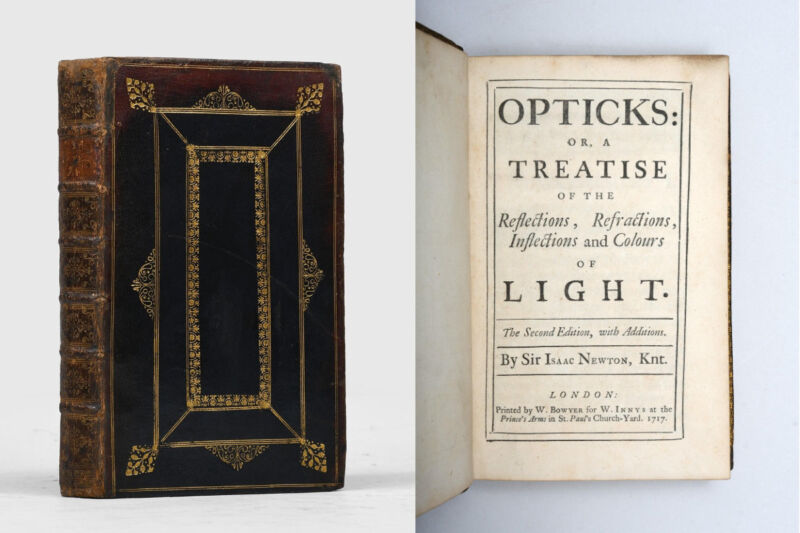Collector discovered Isaac Newton’s lost personal copy of Opticks

Enlarge / Isaac Newton's personal copy of the 1717 second edition of Opticks, long thought lost, has been found. (credit: Peter Harrington Rare Books)
David DiLaura, an emeritus professor at the University of Colorado, was working on his comprehensive bibliography listing every significant scientific volume on optics when he made an unexpected discovery. The copy of Isaac Newton's seminal treatise Opticks that he had purchased some 20 years before turned out to be from Newton's own personal library, believed lost for many decades. The book will go up for sale at the Rare Books San Francisco Fair, February 3-5, 2023, with a price of $375,000.
It's becoming increasingly rare for an author's own copy of a book of this magnitude to fly under the radar for so many years," said Pom Harrington, owner of Peter Harrington Rare Books, which is handling the sale. "When DiLaura bought this copy more than 20 years ago from an English rare book dealer in West Sussex, neither buyer nor seller had any idea of its history. DiLaura has described his discovery as 'a once-in-a-collector's-lifetime event,' and it really is. Collectors and rare book dealers love a good tale of rediscovery, especially one which came to light-quite literally in this case-in the way this one did."Newton is justly most famous for his Principia and the co-invention of calculus, but he also had a longstanding interest in optics. For instance, he once stuck a long sewing needle (bodkin) into his eye socket between the eye and bone and recorded the colored circles and other visual effects he saw. And as a young scientist at the University of Cambridge, he conducted what is known as his experimentum crucis, darkening his room one sunny day and making a hole in the window shutter to let a narrow beam of sunlight into the room. Then he placed a glass prism in the sunbeam and observed the rainbow bands of light in the color spectrum.
When he placed a second prism upside-down in front of the first, the band of colors recombined into white sunlight, thereby proving his hypothesis that white light is made up of all the colors of the spectrum combined. Based on his theory of color, Newton concluded that refracting telescope lenses would be plagued by chromatic aberrations (the dispersion of light into colors) and built the first practical reflecting telescope, using reflective mirrors rather than lenses as the objective to solve that problem. He gave a demonstration of his telescope to the Royal Society in 1671.